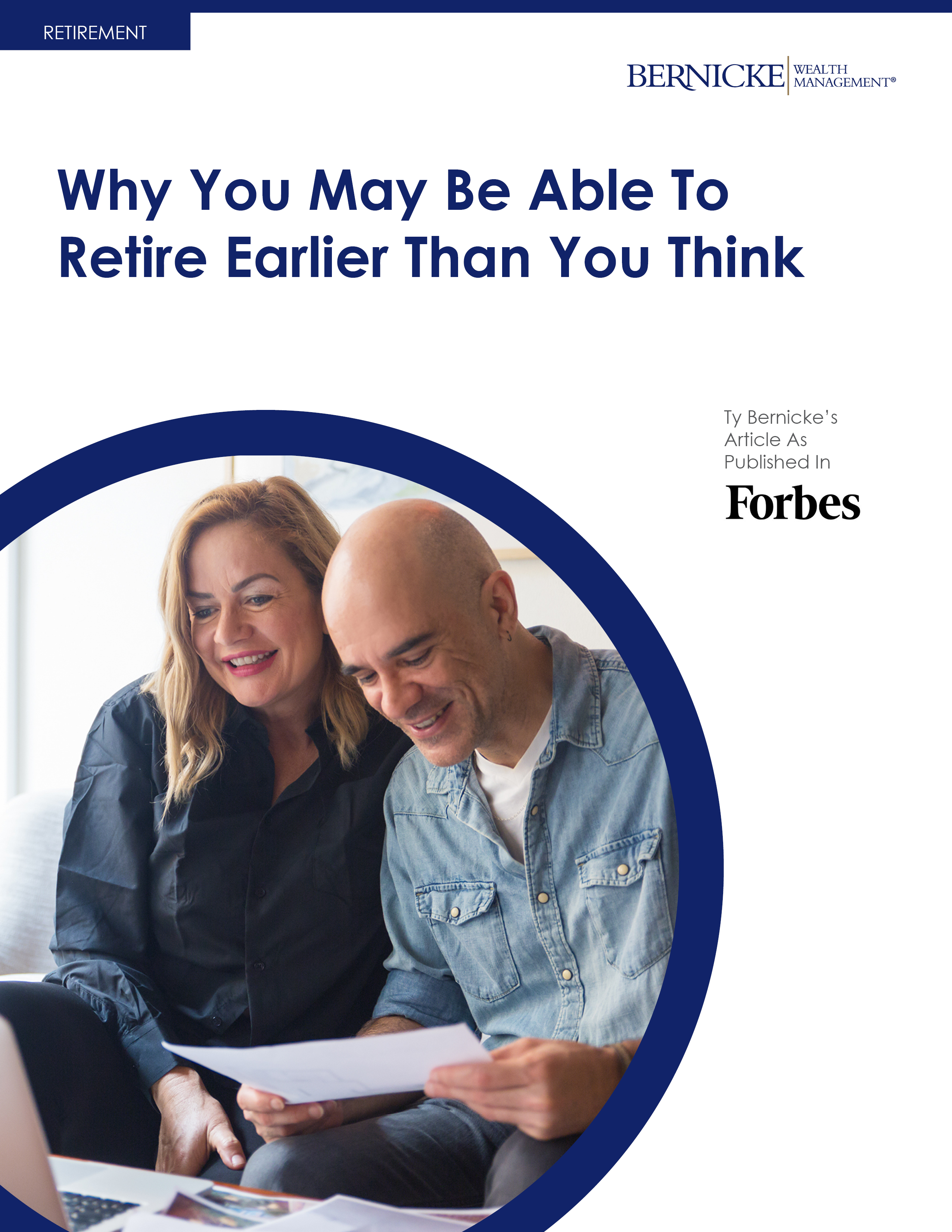In this video, Ty Bernicke, CFP®, President & CEO, breaks down the critical investment strategies for early retirement, focusing on three key investment buckets: tax-deferred, tax-free, and non-qualified accounts. He emphasizes the importance of creating a flexible 10-year retirement plan that considers tax implications, health insurance costs, and strategic withdrawal strategies to maximize financial independence.
Hello everybody. My name is Ty Bernicke, and today I’m going to talk to you a little bit about investment strategies that you must know to retire early.
Diverse Income Sources in Retirement
When you think of where you’re going to get your income in retirement, for most people, they’ll get income from a variety of different sources, especially if they were diligent savers during their working lives.
Most people at some point will have Social Security. Some people might have pension income from an employer they’re leaving or from a previous employer, and many people will supplement their retirement income through their investments. People also might have passive income from rental real estate or business ventures in which they still have partial ownership. There’s a variety of different income sources that most retirees will have.
You might have just 1 or 2 of these, but many people will have a few of them.
Key Considerations for Retirement Income
Now, when we expand on the investment side of the equation and try to think about how do we get income from our investments when we retire, there’s a few key considerations that are extremely important:
- The timing of when you’re going to need to take money out and the amount that you need needs to be considered.
- Of course, the tax implications need to be considered.
- Your health insurance needs prior to Medicare kicking in at 65 should be considered too.
The reason that the health insurance comes into the equation is because many people who retire before the age of 65 will either go on Affordable Care Act insurance or a state-sponsored version of Affordable Care Act insurance, and the cost of those types of insurance programs are actually partially determined by one’s modified adjusted gross income. As your adjusted, modified adjusted gross income goes up, the cost of the health insurance will also generally increase, and as that goes down, the cost of the health insurance prior to Medicare kicking in will also go down.
The Three Investment Buckets
Now to extend this conversation, I think it’s also important to look at how your investments are allocated. This is so important. And if any of you have heard of any of our YouTube videos before or any of our, or seen any of the things that I’ve written about in Forbes, you’ll always hear me talk about these three different buckets of investments. Understanding this key concept is so important because that’s going to drive a lot of those different tax questions and tax minimization strategies in retirement, along with minimizing unnecessary health insurance costs.
So to expand on this, there’s basically three different investment buckets as we talk about with our clients. And you could get more granular than this. But this will generally take care of about 90% of the investments that we see people have. And just imagine for a second that you had to take your own investments and you had to put them into one of these three buckets.
1. The Tax-Deferred Bucket
The tax-deferred bucket would include things like IRA plans, 401(k) plans, 403(b) or 457(b) deferred compensation plans. The way that this bucket works is when you put money into it, your money goes in either on a pretax or tax-deductible basis. And it grows on a tax-deferred basis. But when you start taking money out of this bucket in retirement for income in the year you take it out, you’re going to pay tax on it.
2. The Tax-Free Bucket
This tax-deferred bucket is almost exactly opposite from the tax-free bucket, which would include things like Roth IRA, Roth 401(k), Roth 403(b) and they even have Roth 457 based. And these aren’t all-encompassing of the investments that you can own in each of the buckets, but generally speaking, that’s primarily what we see.
But when you put money into this tax-free bucket, you don’t get any special tax break up front. But the money grows tax-free and it can be withdrawn for qualified reasons, tax-free in retirement. And if you don’t want to withdraw from this bucket during your lifetime, you actually don’t have to. And so this provides a sanctuary from taxes going forward in the future.
3. The Non-Qualified Bucket
The final bucket is what we call non-qualified. And non-qualified to me is basically another way of saying non-retirement, not a retirement account like what we see over here. And depending on the type of investments that you own in this bucket, the dividends or interest income, it’s taxed a little bit differently depending on the type of investment that you own.
But one thing that’s important to know is when you invest money in this bucket, if you put $100,000 into some sort of non-qualified investment, when you take that money back out, you’re not going to have to pay tax on it because you already paid tax on it.
Strategic Planning for Retirement Income
And as you’re looking at these three different buckets, my opinion would be as you’re taking income out in retirement, you have to consider your health insurance needs, your tax needs and the timing of when you’re going to take the money out.
So it almost makes sense to create about a ten-year plan on what investments you’re going to be getting your income from in retirement. And depending on how much you have in each of these buckets, that’ll dictate how much income that you get.
For example, if you have to pay for health insurance prior to Medicare and you have these three buckets and you want to keep your modified adjusted gross income low, you might not want to get all your income from your tax-deferred bucket, because that’s going to increase your taxes and increase your health insurance costs.
You might want to look at taking money from one of these buckets, preferably the non-qualified bucket, if you can take withdrawals of that basis that I just mentioned, absolutely tax-free. And that will also not increase the cost of your health insurance.
So to me, it makes sense to look at each of these different buckets independently from one another to determine how much of each bucket needs to be managed for short-term needs versus long-term needs.
Based on your ten-year tentative game plan. But it’s extremely important that every year you revisit that game plan because your situation can change. Tax laws can change, health insurance laws can change. So go into retirement with a ten-year plan. Figure out what percentage of each bucket needs to be separated into short-term versus long-term, and then adjust your investments according to those needs.
So don’t look at your overall risk tolerance and necessarily say, well, I like to have a balanced portfolio. So I’m going to be balanced here, balanced here and balanced here because you might have significantly higher short-term needs in one of these buckets, which would necessitate getting much more conservative with that bucket. And if you have a different bucket that has much longer-term needs, you could be more growth-oriented.
So you still could have that balanced portfolio when looking at all three of the buckets together. But now you’re strategically thinking about what’s my timing of when I need this money, what is my tax situation, and how is it going to be affected, and how is that going to affect my health insurance costs.
So I hope that you found this helpful as it pertains to figuring out how to invest your money in retirement, according to the buckets that you have.
Have retirement questions?
Schedule a quick 15-minute call with one of our CERTIFIED FINANCIAL PLANNER™ professionals to discuss your most pressing questions related to retirement. You can also reach us directly at (866) 832-1173.
Content in this material is for general information only and not intended to provide specific advice or recommendations for any individual. All investing involves risk including loss of principal. No strategy assures success or protects against loss.




